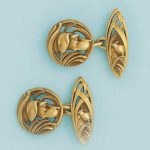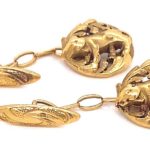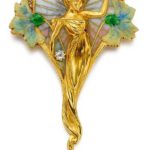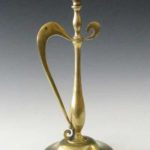Art Nouveau Cufflinks. Although the first cufflinks appeared in the 1600s, they did not become common until the end of the 18th century. Their development is closely related to that of the men’s shirt. Men have been wearing shirt-like items of clothing since the invention of woven fabric 5,000 years BC. Although styles and methods of manufacturing changed, the underlying form remained the same: a tunic opened to the front with sleeves and collar. The shirt was worn directly next to the skin, it was washable and thereby protected the outer garments from contact with the body. Conversely, it also protected the skin against the rougher and heavier fabrics of jackets and coats by covering the neck and wrists.
Colored cufflinks made from gemstones were initially only worn by men with a great deal of self-confidence. However, this situation changed when the Prince of Wales, later Edward VII, popularised colorful Fabergé cufflinks in the 19th century. During this time cufflinks became fashion accessories and one of the few acceptable items of jewelry for men in Britain and the U.S.
This development continued into the early 1900s, with more cufflinks worn than ever before. These were available in every type of form, color, and material, incorporating both gemstones and less precious stones and glass in cheaper copies. Intricate colored enameled cufflinks in every conceivable geometric pattern were especially popular. All of these were of equal value, as Coco Chanel had made fashion jewelry acceptable to wear. In a parallel development, however, a sportier style of shirt emerged with unstarched cuffs that could be secured with simple buttons. Reference: Wikipedia
Below are some examples and price guides of Art Nouveau cufflinks including a pair with the profile head of a hunting dog and a floral pair by Henri-Victor Miault.
A PAIR OF GOLD ART NOUVEAU CUFFLINKS, BY HENRI-VICTOR MIAULT, CIRCA 1900 Single-sided: Each of openwork floral and foliate design, to a terminal of the same design, via a cable-link connector, mounted in gold, one signed Miault, the other with maker’s mark, plaque length 1.7cm
Sold for £ 1,275 inc. premium at Bonham’s in 2019
A pair of Art Nouveau gold cufflinks Each designed as a circular pierced panel modelled as the profile head of a hunting dog within foliate border, the opposing link with torpedo shaped panel modelled with wild foul within leaf border with engraved detail, to chain-link connections, circa 1900, French maker’s lozenge mark with initial G P flanking a clover leaf
Sold for GBP 2,250 at Christie’s in 2011
18k Yellow Gold Weight 11.8g Art Nouveau Tiger Cufflinks Measurements 0.67”x1.4”
Sold for $475 at Intervendue in 2021




